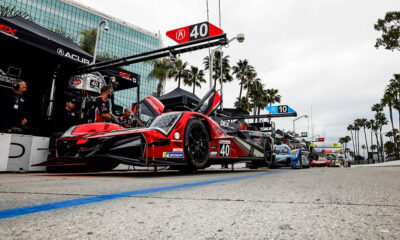
Photo: Michelin
Balance of Performance has been a major talking point in the sports car racing world as of late, including the IMSA WeatherTech SportsCar Championship, which rolled out with its most extensive and data-driven BoP process to date for the 2016 season.
Below is an excerpt from MichelinAlley.com’s interview with WeatherTech Championship Senior Series and Technical Manager Geoff Carter, discussing the BoP process and the advancements made this year.
How does the 2016 BoP process compare to prior years?
Years ago, the BoP was not very well understood from the Competitor/manufacturer standpoint. It wasn’t transparent. It appeared to be working from a black hole with the only data being from timing and scoring. One person was overwhelmed trying to do it all. Now, with series-mandated scrutineering loggers, improved analytic programs, better communications and transparency; the phone rings 80 percent less. We now have six people, plus support from Bosch.
How do you gauge success?
One team principal said that if we walk into a room and there is a negative buzz and everyone is a little bit unhappy then you are probably about right.
You learn to deliver “bad news,” meaning that we are adjusting someone’s performance.
At the Daytona tests earlier in the year, there were reports of widespread sandbagging. How do you detect and deal with sandbagging? Do teams have tricks to try to mask their performance?
We found some teams not using full throttle, running full fuel loads, varying tire pressures well beyond normal ranges, short shifting, braking early, and using “lazy” acceleration. Some guys ran the “wrong” gears to limit RPM. We saw 10 or 11 different mechanisms. GPS can tell us the line the driver took. Some guys at “The Roar” ran the entire test without hitting an apex. Some just rolled into the corners.
What was the most obvious example?
In NASCAR Turn 4, coming onto the front straightaway there were cars where the driver had completely lifted and the throttle position was zero! Of the 52 cars at the Daytona test, all showed some “performance management.”
How did you catch them?
In the past, the only tool that we had was a timing and scoring lap analysis with some very limited vehicle data. Now we have sophisticated data loggers that can overlap with lap times and the timing and scoring loops. After the race at Daytona, our analytics guys had over 100 gigabytes of data. We spent more than 40 hours in Committee meetings reviewing all of this information with the IMSA Technical Committee in order to make BoP recommendations before the next event. In this case it was the Sebring winter test.
Read the full Q&A with Carter on MichelinAlley.com

























